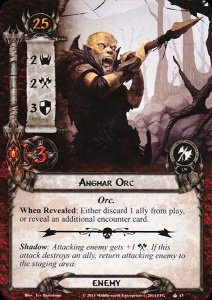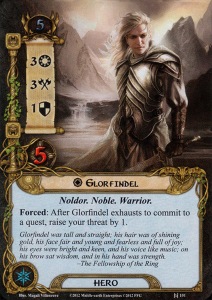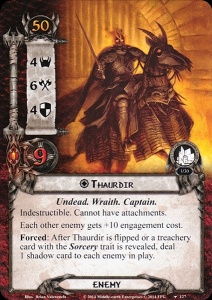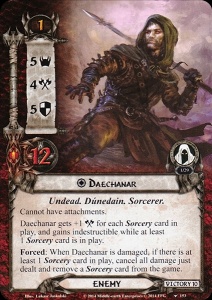Today it’s time for one of my (very) occasional articles. I will be a (mostly) rant-free discussion. This article, like Lord of the Rings, is meant to be the story of a journey. Our quest to rediscover the fun of Lord of the Rings the Card Game.
The Task
I decided that I wanted to work through a full campaign. My wife wanted something set in Gondor or Arnor, which confronting either the Heirs of Numenor (need mono-sphere and the ability to tackle siege/battle questing) or Carn Dum (a definite top-five contender for worst quest ever). I decided to go for Arnor, as Carn Dum is a fair way down the line, and by then we would either have figured things out well enough to make a creditable attempt, or given up.
Taking the Hobbits to Angmar (mar, mar, mar)

Don’t be hasty
The next task was to build decks. The only original/recently-built deck I had, was a Hobbit/Ent deck – Black Riders Merry & Pippin + Folco, with Folco being there to offer early resources then, if necessary, drop threat so that you can avoid enemies long enough to get a board full of Ents established (Treebeard being the most important). For a cycle like Angmar Awakened, I wasn’t at all convinced that would work – it was too slow, and the heroes had too few hit-points. Still, I figured I’d test it out.
Playing on Easy mode, I managed to get Treebeard and a Booming Ent out on turn 1 – knowing I didn’t need to make any optional engagements, I quested with everyone for 7. I revealed a side quest, losing Iarion, but made a single progress. Turn 2, more Ents in play, Treebeard and the Booming Ent ready – then I got a treachery that revealed another card for each quest in play (2), then drew a location, an Angmar Orc (when revealed: discard an ally from play or reveal another card) then another one. Then yet another enemy. Despite questing with all my heroes and an ally, I’d failed questing by 6!
 The Angmar Orc is a great example of how the game has skewed so badly in recent years. For one thing, he’s a hefty enemy – 3 hit points, 3 defence is no joke – Treebeard was the only character who could even damage him on his own. In any of the early cycles, those stats alone would be plenty for the card to contain. Now though, he comes with this pseudo-surge effect: previously surge like this was for flimsy little goblins only. “Easy” mode is anything but.
The Angmar Orc is a great example of how the game has skewed so badly in recent years. For one thing, he’s a hefty enemy – 3 hit points, 3 defence is no joke – Treebeard was the only character who could even damage him on his own. In any of the early cycles, those stats alone would be plenty for the card to contain. Now though, he comes with this pseudo-surge effect: previously surge like this was for flimsy little goblins only. “Easy” mode is anything but.
The Orc War Party, who are the centre-piece of this quest, prevent enemies in the staging area from being damaged, which meant that there was no point even trying my Direct Damage deck (Thalin, Argalad, Beregond), as too many of the features simply wouldn’t work. I was left with a choice of either trying out my Silvan/Victory Display fellowship, or trying to build a new pair of decks.
Where Now are the Dunedain?
I needed something that could handle lots of enemies – realistically that meant a Dunedain deck – Aragorn, Amarthiul, Halbarad, Mablung (not a Dunedan, but fits the archetype well). Then I would need a support deck, something that could quest a lot, and could heal (ideally with card draw and threat control as a bonus). Elrond and Glorfindel + someone seemed a good fit here (Elrond for healing, Glorfindel for low threat, both give access to powerful Noldor cards, and you can get Asfaloth, Vilya etc). Amarthiul appears in objective ally form in several of the quests in this cycle, so I ruled him out.
 In the end, I created a completely illegal, but fun-looking fellowship that I called “The Once and Future King” – A Halbarad/Mablung/Tactics Aragorn deck on one side, and an Elrond/Spirit Glorfindel/ Lore Aragorn deck on the other. Rather than include them here, you can find the Fellowship on Rings DB.
In the end, I created a completely illegal, but fun-looking fellowship that I called “The Once and Future King” – A Halbarad/Mablung/Tactics Aragorn deck on one side, and an Elrond/Spirit Glorfindel/ Lore Aragorn deck on the other. Rather than include them here, you can find the Fellowship on Rings DB.
Both of the decks struggled a bit with card draw, and there were definitely issues getting some of the key cards (I really needed Song of Kings, as Mablung racked up an ever-bigger stack of cash, and I only found Leadership cards to play).
I’d used Sword that was Broken in Dunedain decks in the past, but found it really hard to get out cost-wise, and that I wasn’t sending enough people to the quest to make it worthwhile. For this fellowship, adding it to Loragorn meant that the Willpower boost was typically a lot more effective/worthwhile, even though it’s still hard to afford early on.
Raiment of War (for Vigilant Dunedain) – 6 is a lot of resources, but you get a 3 defence, 5 hit-point, non-exhausting enemy (that can be healed)
The version here is more-or-less what I used from Deadman’s Dyke onwards. Early drafts had more mounts and fewer weapons, but this just felt a bit easier to leverage.
Beginng the Campaign
The first two quests – Intruders in Chetwood and the Weather Hills – saw a fair amount of chopping and changing on our part, as we got used to the rhythm of the decks.
 One thing I did notice about ‘Easy Mode’ is how thick and fast the side quests come. This was the first box to feature side quests, so there were quite a lot of them anyway but, as none of them get removed when filtering out the non-easy cards, the concentration is quite high early on, making the Encounter Cards that are X “Where X is the number of quest cards in play” particularly nasty. However, that also means that, once you’ve weathered the early assault, you’re probably fairly well set, as most of the really game-wrecking treacheries have been removed.
One thing I did notice about ‘Easy Mode’ is how thick and fast the side quests come. This was the first box to feature side quests, so there were quite a lot of them anyway but, as none of them get removed when filtering out the non-easy cards, the concentration is quite high early on, making the Encounter Cards that are X “Where X is the number of quest cards in play” particularly nasty. However, that also means that, once you’ve weathered the early assault, you’re probably fairly well set, as most of the really game-wrecking treacheries have been removed.
Continuing the Journey
 The next steps went well too – we cleared Deadman’s Dyke, and the first quest of the cycle proper, Wastes of Eriador. I’m still not a fan of Wastes – it has an annoying feature where every other round it’s night and you can’t place progress on any quest, plus an incredibly irritating treachery that suddenly makes it night mid-way through the quest phase. Fortunately, in “Easy Mode” you can survive the extra rounds (there is still A LOT of combat, and the Wardens of Healing + Elrond’s effect were working overtime), and we got out the other side in one piece.
The next steps went well too – we cleared Deadman’s Dyke, and the first quest of the cycle proper, Wastes of Eriador. I’m still not a fan of Wastes – it has an annoying feature where every other round it’s night and you can’t place progress on any quest, plus an incredibly irritating treachery that suddenly makes it night mid-way through the quest phase. Fortunately, in “Easy Mode” you can survive the extra rounds (there is still A LOT of combat, and the Wardens of Healing + Elrond’s effect were working overtime), and we got out the other side in one piece.
Getting out of Here
Escape from Mount Gram is probably the quest I know best in this cycle, I haven’t started it quite as many times as Battle of Carn Dum, but a lot of that is down to the fact that it’s (broadly) an easier quest), at least for solo play. For anyone not familiar with it, this quest is basically a prison break – all your allies, mounts, items and artifacts are taken away, and you need to get out of the dungeon despite starting with only a single hero, and whatever was left of your deck (generally events and condition attachments).

Looks like you’re on your own
One of the biggest challenges of this scenario was the way it splits your party up – the Elf deck was alright starting with Glorfindel only, particularly with a decent chance of drawing into Light of Valinor and/or Unexpected Courage early on, but solo Halbarad is a different proposition altogether: on our first attempt, I had to engage a couple of enemies to avoid the staging area getting completely gridlocked, and then got killed by a nasty shadow card or 2. Second time round, things went a bit better: I was still mostly just treading water, but managed to survive long enough to team up with the elves. A lot of cards in this scenario have the “capture” mechanic, with some of the cards that were taken away from you at the start being hidden underneath them and returned to your hand (or sometimes directly to play) when that card is dealt with. By the time we joined together, Elrond and Glorfindel, were backed up by Arwen, Yazan, Gildor, a stargazer and a healer!
The Dunedain came good in the end, managing to 1-shot the boss enemy as we burst out of the dungeon. Victory at the second attempt, and onto the next.
There’s Moor!
Once you make it out of Mount Gram, you need to head Across the Ettenmoors, where you will find a lot of trolls. It’s a quest I’ve only played once or twice, notorious for being the pack which gave us the truly dreadful Hero Dori.
This is an odd quest, and re-playing it didn’t massively alter my feelings in that regard – Stage 1 forces you to have a side quest in play every round, and as mentioned already, the side-quests come pretty thick and fast in Easy Mode anyway. By the end of the game, we’d cleared out the full set of side quests, and with only a limited number of enemies in the deck, it was just a case of surviving until the side-quests had been cleared, then a fairly easy move to the end.
 After the Ettenmoors, came the Treachery of Rhudaur – this is very much a momentum quest, with a hard-cap 5-round time-limit on stage 1, as you try to collect various side-quests which turn into objective-attachment rewards. This was definitely a quest where the easy-mode set-up made a big difference, and even though there were points where we got a bit swamped by enemies, we got all 3 objectives, and completed the quest fairly comfortably.
After the Ettenmoors, came the Treachery of Rhudaur – this is very much a momentum quest, with a hard-cap 5-round time-limit on stage 1, as you try to collect various side-quests which turn into objective-attachment rewards. This was definitely a quest where the easy-mode set-up made a big difference, and even though there were points where we got a bit swamped by enemies, we got all 3 objectives, and completed the quest fairly comfortably.
Battles lost and… lost
 The penultimate quest in this cycle is The Battle of Carn Dum. Quite possibly the worst quest ever designed for the game. Being tortured by Nazgul who want you to surrender the location of the one ring is probably quite pleasant in comparison.
The penultimate quest in this cycle is The Battle of Carn Dum. Quite possibly the worst quest ever designed for the game. Being tortured by Nazgul who want you to surrender the location of the one ring is probably quite pleasant in comparison.
For a 2-player game, you start with a 4-threat boss enemy in the staging area, a 2-threat location, and 2 1-threat* enemies. (so, that’s 8).
 Carn Dum does a lot of playing with Shadow cards: the “1-threat” enemies get +1 threat for each shadow card they have. The boss enemy deals a shadow card to each enemy in play every time a treachery with the Sorcery keyword is revealed. So, each sorcery treachery is cranking the threat up by 2, as well as its effect (and some have surge). Shadow Cards in Carn Dum are only discarded once they are resolved, so as long as these sit in the staging area, the threat is just going up and up.
Carn Dum does a lot of playing with Shadow cards: the “1-threat” enemies get +1 threat for each shadow card they have. The boss enemy deals a shadow card to each enemy in play every time a treachery with the Sorcery keyword is revealed. So, each sorcery treachery is cranking the threat up by 2, as well as its effect (and some have surge). Shadow Cards in Carn Dum are only discarded once they are resolved, so as long as these sit in the staging area, the threat is just going up and up.
Of course, you can engage the enemies to avoid their threat – but at 4 attack, 3 defence and 5 hit points, you’re likely to take significant damage, and probably won’t kill it in a single round.
I haven’t crunched the numbers, but I think realistically you’re looking at having at least 12 threat to quest against in round 1, as well as having to take on at least an enemy each (and a big one at that).
Every few rounds, the boss enemy is going to get up to having 3 shadow cards on him, at which point he flips, makes an immediate attack against the first player, and suddenly lowers the engagement cost of every other enemy in play by 10, at which point you get swarmed by anything that hasn’t engaged you already.
We played this 3 times, not coming close to beating it on any occasion.
The point of this exercise was to play through a full cycle with a pair of decks – I’ve made tweaks as we go along, and certainly wouldn’t mind making a few more. But there’s a difference between tweaking and completely custom-building new decks, and I just can’t see any version of these decks beating the quest. Given that the other point of this whole activity was to have some fun, I decided to just give up and move on…
The Final Battle
 Final scenario in the cycle is The Dread Realm – we definitely had to grapple with this one, taking a long time to get anywhere. The big new thing, is face-down cards from players decks (or occasionally their discard piles) being “reanimated” as 2-2-2-2 undead enemies – there are lots of effects that will reanimate more cards, and other cards which key off of it, so this is a fairly major thing to deal with. Once you get through the early part of the game, there is also a fairly nasty end-of-campaign boss in Daechanar (an evil spirit who has stolen the body of your kidnapped friend who you have spent the campaign trying to rescue). He gets +1 attack for every sorcery card in play (there are various treacheries with this keyword that turn into attachments), and cannot be damaged whilst these are in play – instead you remove a Sorcery card from the game for each instance of damage: as there’s a chance that more sorcery will be churned out every round, you need multiple ways to damage him each round to be able to take him down.
Final scenario in the cycle is The Dread Realm – we definitely had to grapple with this one, taking a long time to get anywhere. The big new thing, is face-down cards from players decks (or occasionally their discard piles) being “reanimated” as 2-2-2-2 undead enemies – there are lots of effects that will reanimate more cards, and other cards which key off of it, so this is a fairly major thing to deal with. Once you get through the early part of the game, there is also a fairly nasty end-of-campaign boss in Daechanar (an evil spirit who has stolen the body of your kidnapped friend who you have spent the campaign trying to rescue). He gets +1 attack for every sorcery card in play (there are various treacheries with this keyword that turn into attachments), and cannot be damaged whilst these are in play – instead you remove a Sorcery card from the game for each instance of damage: as there’s a chance that more sorcery will be churned out every round, you need multiple ways to damage him each round to be able to take him down.
We got there in the end, but it was a bit of a slog, and we felt pretty exhausted by the end.
Final Thoughts
As I said at the start, this campaign was about trying to recapture the fun of this game, and overall I think it succeeded. In some instances “easy” mode definitely was easy, and I wouldn’t have minded a bit more of a challenge, but there were plenty of other times when it was still tough, and at least one scenario (Carn Dum) that remained stupid and broken.
I like this approach to the game – building a pair of decks and trying to take them through a broader sweep of scenarios. Inevitably, I think that’s going to need to still be on Easy Mode, because I don’t want to have to micro-tweak the deck before/after each and every scenario. I no longer promise/threaten regular content updates on this blog, but I might post periodic threads like this if the content presents itself.

Lost Realm on normal difficulty caused me to hang up on the Lord of the Rings LCG and I haven’y picked it back up in 18 months. The difficulty tended to be so extreme that it felt like I was beating my head against a wall because it felt good when it stopped.
Thematically it was cool and some of the quests were really interesting, but the difficulty level, number of ongoing effects and modifications to keep up with, and need to completely retool a deck for each quest ultimately turned me off.
One of my conclusions: I really don’t care for deck optimization. A little tweaking is fine; the sort of deck build/light modification that the Arkham Gorror LCG offers is comfortable. But LotR in its later days took it to an extreme just to get past “normal” quests.
Shame, ’cause I love the world and the art in the game.